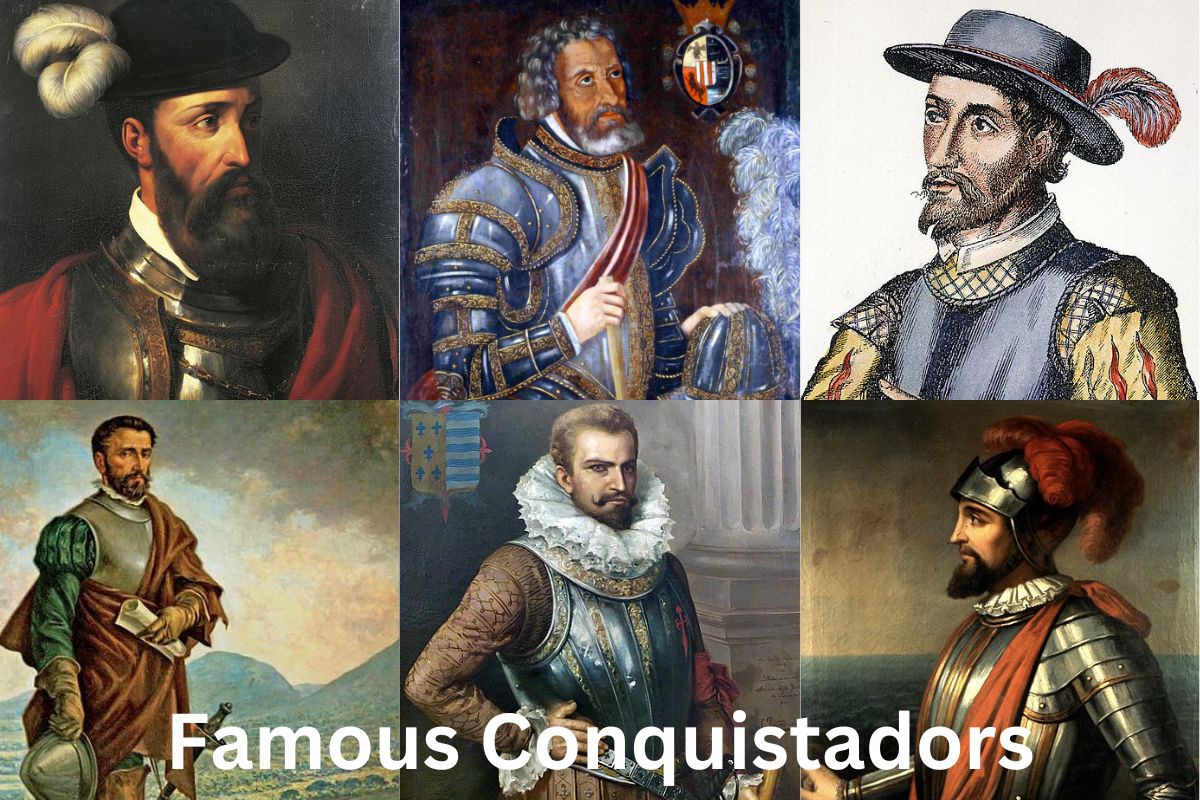The Conquistadors were Spanish and Portuguese explorers and soldiers who played an important role in the 16th century exploration, conquest, and colonization of the Americas.
They were driven by a desire to expand the Spanish and Portuguese empires, promote Religion, and amass fortune by exploring and exploiting new regions.
The Conquistadors conquered the Aztec, Inca, and Maya empires and created Spanish and Portuguese colonies throughout Central and South America, led by leaders such as
- Hernán Cortés
- Francisco Pizarro
- Pedro de Alvarado.
They came into contact with and interacted with many indigenous peoples and cultures, establishing a legacy of cultural exchange and transformation that continues to impact the Americas to this day.
While the Conquistadors are honored as forefathers of exploration and conquest, their legacy also includes bloodshed, oppression, and exploitation of indigenous peoples. Their acts destroyed innumerable villages, cultures, and languages, and had a significant impact on the history of the Americas.
Famous Conquistadors
1. Hernán Cortés
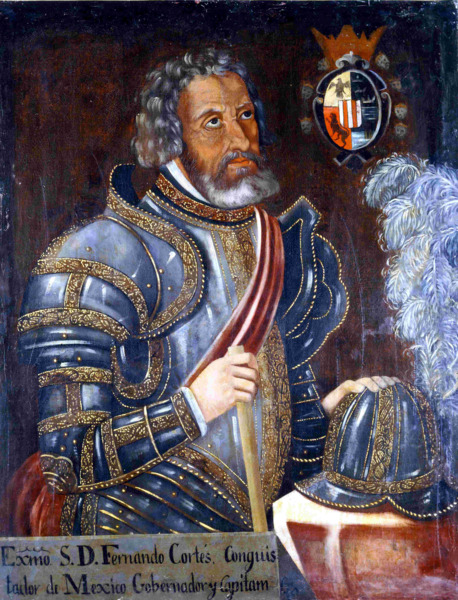
Hernán Cortés was a Spanish conquistador most known for his victory over the Aztec Empire in modern-day Mexico. He was born in Spain in 1485 and came to the Americas about 1504.
In 1519, Cortés led an expedition to Mexico with the goal of discovering wealth and expanding Spanish rule. He came into the domain of the Aztec Empire and fought a two-year conquest campaign against the Aztecs, eventually conquering their capital city of Tenochtitlán.
Also Read: Hernán Cortés Facts
Cortés’ assault of the Aztec Empire was brutal, killing thousands of Aztecs. Yet, it paved the way for Spanish colonization of Mexico and the rest of Central and South America.
Cortés is remembered in the Americas as an emblem of Spanish colonization and conquest. His legacy is complicated by the reality that his conquests were tarnished by murder, exploitation, and the destruction of indigenous civilizations.
He is also credited with shaping early American history and the global exchange of ideas, products, and people.
2. Francisco Pizarro
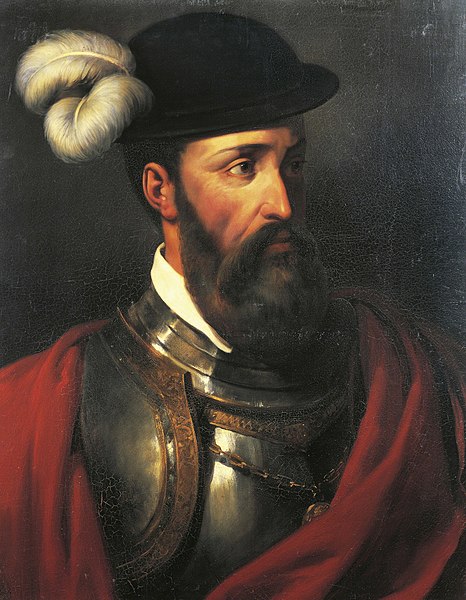
Francisco Pizarro was a Spanish conquistador most known for his victory against the Inca Empire in modern-day Peru. He was born in Spain in 1471 and came to the Americas about 1502.
Pizarro led an expedition to Peru in 1531 with the goal of acquiring money and expanding Spanish dominion. He came in the Inca Empire’s dominion and waged a conquest campaign against the Incas for several years, eventually capturing Cuzco, the Incas’ capital city.
Also Read: Timeline of the Spanish Colonization
Pizarro’s invasion of the Inca Empire was marked by violence, exploitation, and the ruin of Incan civilization. But, it did pave the way for Spanish colonization of Peru and the rest of South America.
Pizarro is remembered in the Americas as an emblem of Spanish colonialism and conquest. His conquests murdered thousands of Incas and ruined their culture and way of life, tarnishing his reputation.
3. Juan Ponce de León
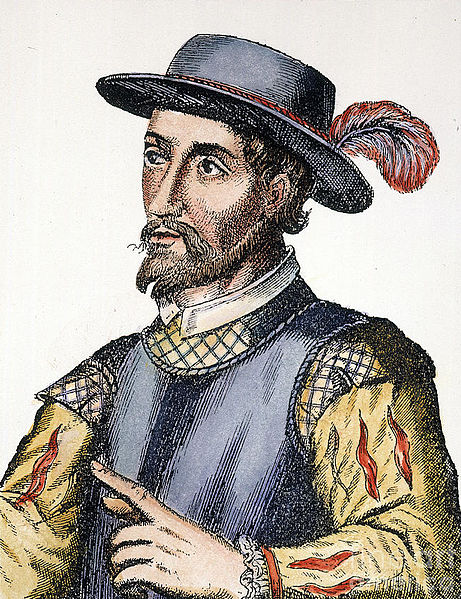
Juan Ponce de León was a Spanish explorer most known for exploring Florida and seeking the legendary Fountain of Youth. He was born in Spain in 1474 and journeyed to the Americas several times.
Ponce de León led an expedition to Florida in 1513, when he established the first Spanish settlement on the mainland of North America. He dubbed the region Florida, which means “flowery” in Spanish, because of the lush vegetation he discovered.
Ponce de León is also known for his search for the Fountain of Youth, a mythical fountain that was said to restore youth and vigour to anybody who drank from it. Despite not discovering the Fountain of Youth, his quest contributed in the exploration and colonization of Florida.
Ponce de León returned numerous times to the Americas, including an ill-fated voyage to Florida in 1521, during which he was wounded by a native arrow and died as a result of his injuries.
Nowadays, Ponce de León is remembered for his key role in Spanish discovery and colonization of the Americas. His travels helped to spread Spanish influence in the region and paved the way for the colonization of Florida and other parts of North America.
4. Francisco Vázquez de Coronado
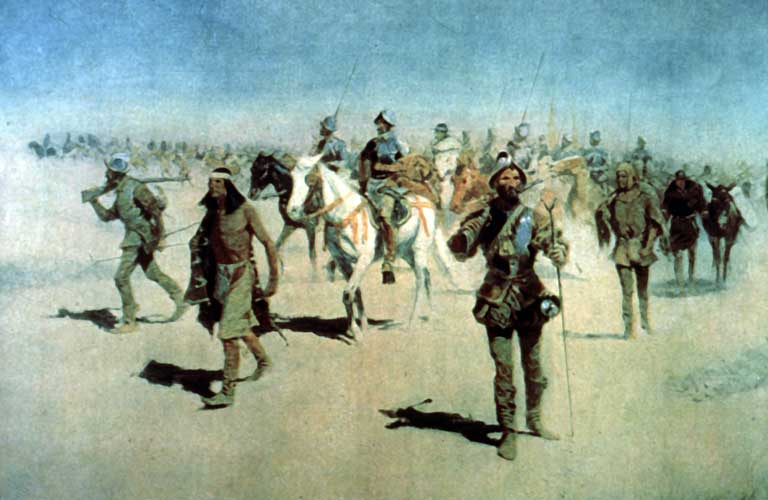
Francisco Vázquez de Coronado was a 16th-century Spanish conquistador best remembered for commanding an expedition into what is now the southwestern United States. Around 1510, he was born into a wealthy family in Salamanca, Spain.
He landed in Mexico in 1535 as part of an expedition led by the first viceroy of New Spain, Antonio de Mendoza.
Coronado was named governor of Nueva Galicia, an area in western Mexico that comprised present-day Jalisco, Nayarit, and Sinaloa. During his governorship, he was given the duty of heading an expedition to uncover the fabled Seven Cities of Gold, which were said to be located to the north of New Spain.
Coronado led a huge expedition of over 1,000 Spanish soldiers and indigenous allies, including Hopi, Zuni, and Pueblo peoples. The voyage passed through what is now Arizona, New Mexico, Texas, Oklahoma, and Kansas, passing through several indigenous tribes and villages.
Coronado and his troops never discovered the Seven Cities of Gold, which turned out to be a legend. The voyage did, however, lead to the discovery of the Grand Canyon and other major features. Coronado returned to Mexico City in 1542 after three years of travel, where he received criticism for failing to uncover the fabled treasure.
Coronado stayed in Mexico until 1554, when he died. While his mission did not accomplish its stated goal, it is acknowledged as a pivotal episode in the history of Spanish exploration of the Americas.
5. Álvar Núñez Cabeza de Vaca
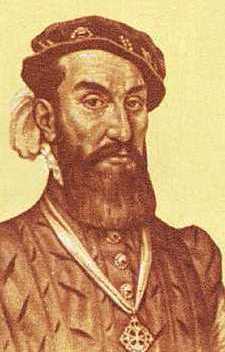
lvar Nez Cabeza de Vaca was a 16th-century Spanish explorer best remembered for his trip through what is now the southern United States. He was born in 1490 in Jerez de la Frontera, Spain, to a noble family. In 1527, he was named treasurer of an expedition to Florida to establish a colony and look for riches.
The mission, however, encountered a number of setbacks, including shipwrecks, attacks by indigenous tribes, and sickness. Cabeza de Vaca was among the few survivors, along with three other Spaniards: Andrés Dorantes de Carranza, Alonso del Castillo Maldonado, and Estevanico, a Moorish slave.
After journeying through what is now Texas, New Mexico, and northern Mexico for several years, the company arrived at the Spanish colony of Culiacán in 1536.
They had learned to survive among indigenous tribes by imitating their customs and depending on their knowledge of local plants and animals. Cabeza de Vaca became well-known for his healing powers and conducted a variety of medical treatments, giving him the moniker “El Médico.”
After returning to Spain in 1537, Cabeza de Vaca published “Naufragios” (“Shipwrecks”), an account of his travels that is now regarded a masterpiece of early Spanish-American literature. He recounted his interactions with indigenous tribes, his experiences as a slave, and his observations of the natural environment in the book.
Cabeza de Vaca later became governor of Argentina’s province of Rio de la Plata, although his tenure was marred by dispute with other Spanish officials. He returned to Spain in 1559 and died in 1560 in Seville. His significance as a forefather explorer and recorder of the early Spanish presence in the Americas endures to this day.
6. Pedro de Alvarado
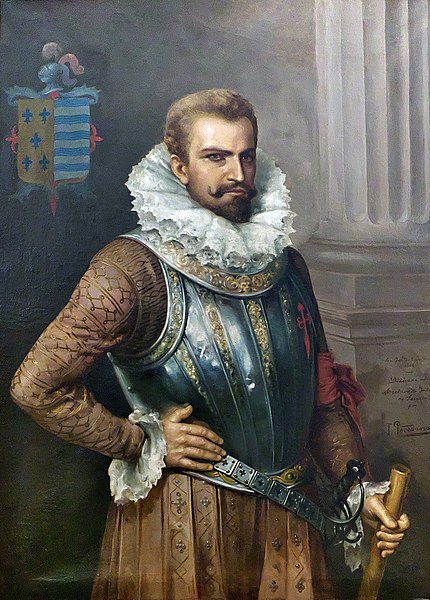
Pedro de Alvarado was a Spanish conquistador who was instrumental in the Spanish conquests of Mexico and Guatemala in the 16th century. He was born in Badajoz, Spain in 1485 and arrived in the New World in 1510 as part of the expedition headed by Juan de Grijalva.
In 1519, Alvarado accompanied Hernán Cortés in his invasion of the Aztec Empire in Mexico. He was a prominent figure in the collapse of Tenochtitlan, the Aztec capital, and eventually served as ruler of the province. In 1524, he was tasked with overseeing the conquest of Guatemala, which was then inhabited by the Maya.
Alvarado was known for his vicious war tactics, and his conquest of Guatemala was marred by murder and brutality. He demolished indigenous settlements, enslaved the populace, and demanded tribute from conquered peoples.
Despite this, he was noted for his administrative ability and is credited with building the colonial city of Antigua Guatemala, which remained as Guatemala’s capital for more than two centuries.
Alvarado was also instrumental in the Spanish colonization of what is now El Salvador. In 1525, he founded San Salvador, which became the colony’s capital.
Alvarado died in 1541 while on an expedition to Peru. He is recognized as a contentious character in the history of Spanish colonialism, with some considering him as a cruel conqueror and others seeing him as a visionary leader who played a vital part in the creation of Spanish power in Central America.
7. Gonzalo Jiménez de Quesada
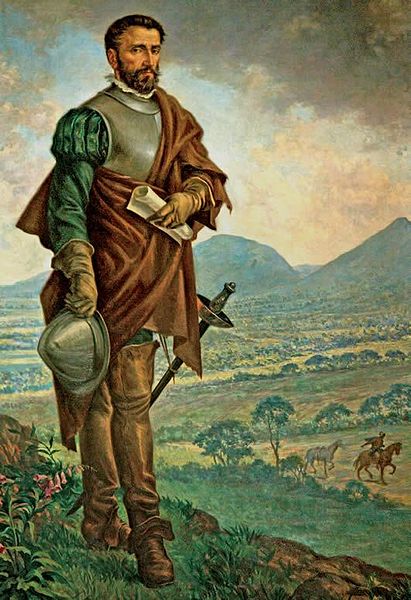
Gonzalo Jiménez de Quesada was a 16th-century Spanish conquistador who commanded the expedition that discovered the Bogotá plateau in modern-day Colombia. He was born in 1509 in Córdoba, Spain, and landed in the New World in 1536 as part of an expedition to explore South America’s northern coast.
Quesada led an expedition of 800 soldiers and 4,000 indigenous allies from Santa Marta on the Caribbean coast to the Colombian highlands in 1537. Along the journey, the expedition encountered a number of indigenous populations, with some of which Quesada clashed violently.
Quesada and his warriors arrived at the Bogotá plateau, which they christened the New Kingdom of Granada after months of journey. They came across the Muisca people, who were noted for their intricate goldwork. Quesada and his troops captured huge quantities of gold from the Muisca, and in 1538, he founded the city of Santa Fe de Bogotá, which would later become Colombia’s capital.
Quesada later became governor of the New Kingdom of Granada and was well-known for his efforts to establish Spanish sovereignty in the region. He was also involved in the Amazon River exploration, and his observations of the region’s geography and indigenous peoples influenced European perception of the region.
Quesada died in 1579, but his legacy as a pioneering explorer and conqueror in South America lives on. He is recognized for his contributions to early mapping and exploration of the continent, as well as his participation in the creation of Spanish colonization in the region.
8. Vasco Núñez de Balboa
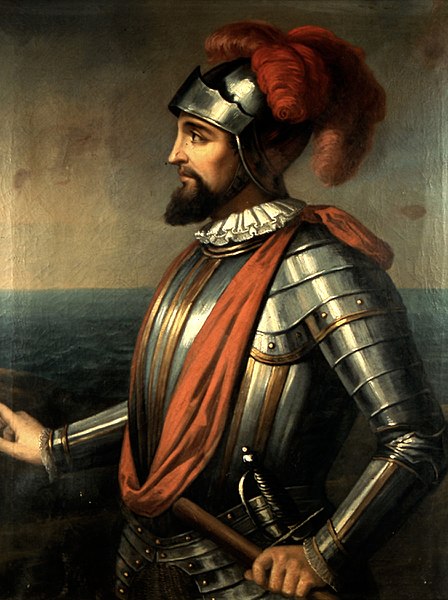
Vasco Nez de Balboa was a Spanish conquistador primarily remembered for his role in the 1513 discovery of the Pacific Ocean. He was born in 1475 in Jerez de los Caballeros, Spain, and came in the New World as part of an expedition led by Rodrigo de Bastidas in 1500.
Balboa founded a town on the coast of modern-day Panama in 1510, which he named Santa Mara la Antigua del Darién. He then began exploring the surrounding area, which was home to the Kuna and other indigenous communities.
Balboa launched an expedition over the Panama Isthmus to the Pacific coast in 1513, becoming the first European to view the ocean. He claimed the ocean and its whole coastline for the Spanish crown, naming it the South Sea.
Balboa’s exploits made him a popular figure among the Spanish colonists, but the governor of Panama, Pedro Arias Dávila, finally accused him of insubordination and treason. In 1519, he was captured, tried, and killed.
Although his premature demise, Balboa’s discovery of the Pacific Ocean was a watershed point in Spanish exploration of the Americas. It opened up new opportunities for trade and exploration, paving the path for eventual Spanish colonization of the Philippines and other Pacific islands.
9. Hernando de Soto
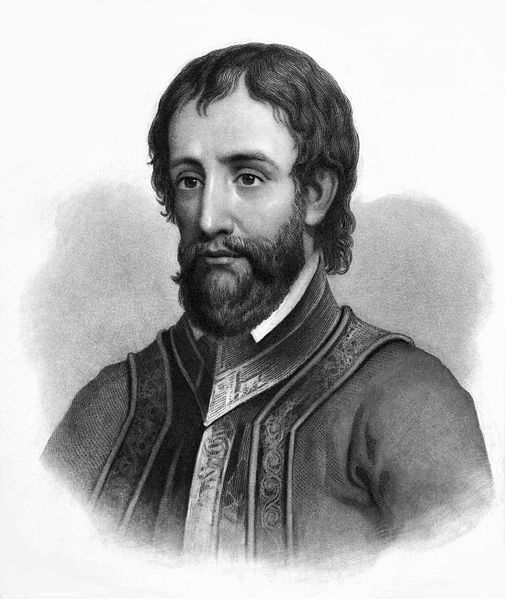
Hernando de Soto was a Spanish explorer most known for discovering the southeastern United States, which included what is now Florida, Georgia, and Alabama. He was born in Spain in 1496 and visited the Americas several times.
De Soto led an expedition of almost 600 people to Florida in 1539 in quest of riches and to expand Spanish dominance. For the next four years, he traveled over the majority of the southeastern United States, encountering several indigenous civilizations and forging alliances and fights with various tribes.
Also Read: Hernando de Soto Facts
De Soto’s expedition was marked by violence and exploitation, which resulted in the deaths of thousands of indigenous people. But, it did pave the way for Spanish colonization of the southeastern United States and the establishment of Pensacola, Florida.
Nowadays, De Soto is regarded as a crucial role in the history of Spanish exploration and colonization of the Americas. His missions helped to spread Spanish dominance in the southeastern United States, laying the groundwork for later settlement and colonization in the region.
10. Juan de Oñate
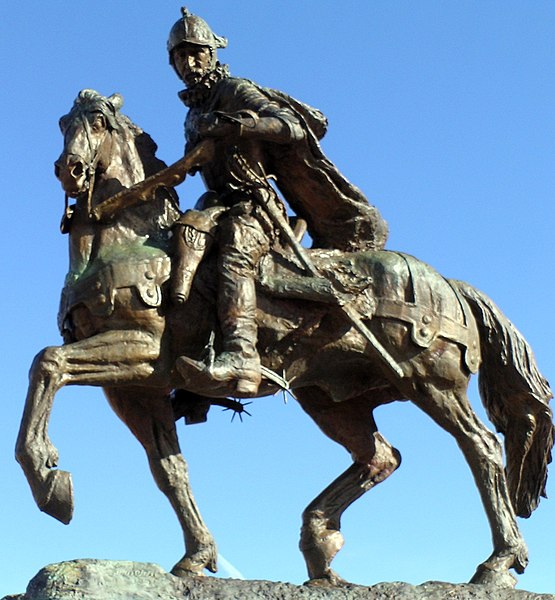
Juan de Oate was a Spanish conquistador who played an important part in the 16th century colonization of what is now New Mexico and the American Southwest. He was born around 1550 in Zacatecas, Mexico, to a distinguished family of conquistadors.
Oate was appointed governor of the Spanish province of New Mexico in 1595, which included much of modern-day New Mexico, Arizona, and sections of Colorado, Utah, and Kansas. He led an expedition of 500 soldiers, settlers, and missionaries from Mexico to New Mexico, passing through various indigenous settlements.
During his governorship, Oate created the city of Santa Fe, a number of Spanish towns in the region, and managed the establishment of the Catholic Church in the province.
He also led multiple excursions in pursuit of fresh sources of wealth and territory to conquer, including an unsuccessful attempt to conquer the Great Plains Pueblo people.
Unfortunately, Oate’s reign was marred by conflict with indigenous people and other Spanish officials. He was removed from his job in 1606 after being accused of harshness and brutality toward the Pueblo people. He was eventually tried and exiled from New Mexico, where he spent the remainder of his life in relative obscurity.
Despite his contentious legacy, Oate is remembered as a pivotal player in the history of Spanish colonization of the Americas and exploration of the American West. His expeditions aided in the establishment of Spanish power in the region, paving the door for further colonization and settlement.
11. Gaspar de Portolá
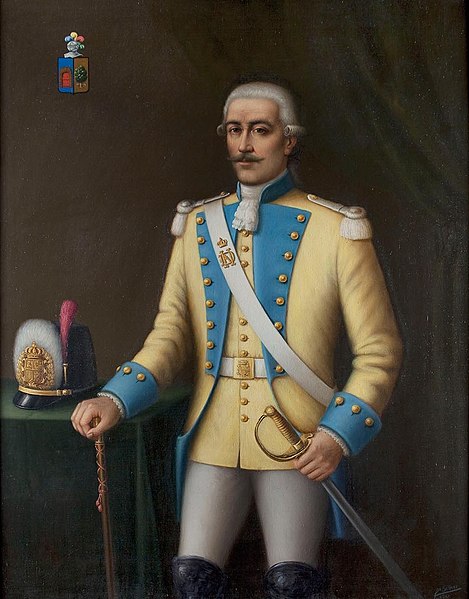
Gaspar de Portolá was a Spanish soldier and explorer who was instrumental in the 18th century colonization of California. He was born in 1716 in Os de Balaguer, Spain, and arrived in Mexico as a captain in the Spanish army in 1746.
Portolá was appointed governor of the Californias, a Spanish province that comprised modern-day California, Baja California, and parts of Arizona, Nevada, and Utah, in 1767. He was tasked with establishing a Spanish presence in California, which was virtually unknown to Europeans at the time.
Portolá led an expedition of approximately 60 troops and missionaries north from San Diego to Monterey, California, in search of a suitable site for a Spanish town in 1769.
Along the route, the expedition encountered various indigenous groups and experienced a variety of hardships, including rough terrain, inclement weather, and food shortages.
Portolá and his troops arrived in Monterey after several months of travel, where they constructed a Spanish presidio and mission. Portolá later led numerous further excursions in California, including one to the San Francisco Bay.
Portolá’s travels aided in the establishment of a Spanish foothold in California, paving the stage for additional colonization and settlement. He is renowned as a pioneering explorer and a pivotal role in California and the American West history. Numerous localities in California are named after him, notably the city of Portola and the Portola Redwoods State Park.
12. Sebastián Vizcaíno
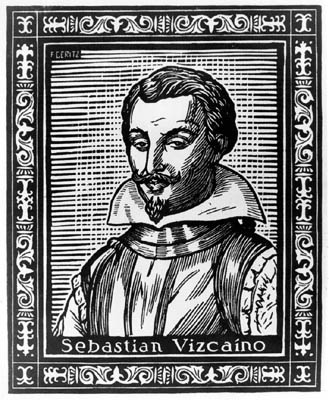
Sebastián Vizcano was a 17th-century Spanish explorer well known for his discovery of the California coast. In 1548, he was born in Extremadura, Spain, and arrived in the New World as part of an expedition to the Philippines in 1583.
The Spanish government commissioned Vizcano to organize an expedition to chart the coast of California and establish Spanish settlements in the region in 1602. From Mexico to California, he led a fleet of three ships and a crew of about 200 soldiers and sailors, passing through various indigenous settlements.
Vizcano explored the California coast from San Diego to Monterey and established several Spanish colonies, including San Diego, Monterey, and Santa Barbara, during his trip. He also named many of the region’s geographical features, such as Point Reyes and Carmel Bay.
Vizcano’s travels aided in the establishment of a Spanish foothold in California, paving the door for further colonization and settlement.
He is renowned as a pioneering explorer and a pivotal role in California and the American West history. Numerous places in California bear his name, including Vizcaino and the Vizcaino Desert Preserve.
13. Nuño de Guzmán
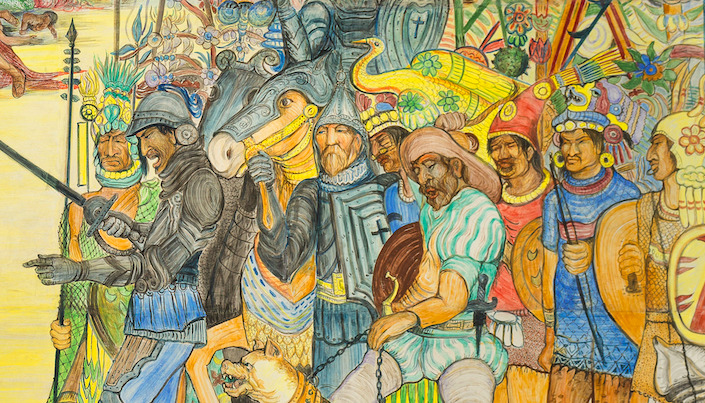
Nuo de Guzmán was a Spanish conquistador who helped to establish Mexico’s early colonization in the 16th century. He was born in 1499 in Guadalajara, Spain, and came in the New World in 1528 as part of Hernán Cortés’ expedition.
Guzmán was named governor of Nueva Galicia, an area in western Mexico that comprised present-day Jalisco, Nayarit, and Sinaloa. Guzmán conducted multiple excursions in quest of new areas to conquer during his governorship, including a disastrous effort to acquire what is now California.
Guzmán’s rule, on the other hand, was defined by violence and brutality toward indigenous communities. He is famous for his brutal treatment of Caxcan and other indigenous peoples, whom he enslaved and put to work in mines and other labor-intensive enterprises. His acts generated significant hatred among the locals, and he was eventually removed from his position in 1536.
Guzmán was tried and convicted of various crimes after being removed from office, including the murder of a bishop. He was forced to flee Mexico and died in Spain in 1558.
Regardless of his contentious legacy, Guzmán is remembered as a pivotal figure in the history of Spanish colonialism in Mexico. His expeditions aided in the establishment of Spanish power in the region, paving the door for further colonization and settlement.
Nonetheless, his acts harmed indigenous communities and served as a reminder of the catastrophic consequences of colonialism on the peoples of the Americas.
